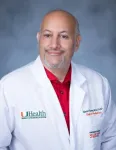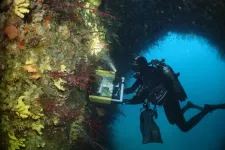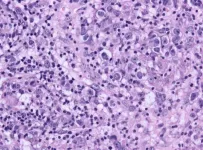(Press-News.org) DALLAS (SMU) – SMU nanotechnology expert MinJun Kim and his team have been awarded a $1.8 million, R01 grant from the National Institutes of Health (NIH) for research related to gene therapy – a technique that modifies a person’s genes to treat or cure disease.
NIH R01 (Research Program) grants are extremely competitive, with fewer than 10 percent of applicants receiving one.
The four-year grant will allow Kim, the Robert C. Womack Chair in the Lyle School of Engineering at SMU (Southern Methodist University) and principal investigator of the BAST Lab, to develop a simpler, more effective way to accurately determine whether viruses intended for gene therapy contain their full genetic cargo.
Nanoparticles are too small to be visible to the naked eye – ranging in size from 1 to 100 nanometers (one billionth of a meter) in size. Nanomaterials can occur naturally and can also be engineered to perform specific functions, such as the delivery of drugs to various forms of cancer. Viruses are soft nanoparticles.
The protein coat surrounding the nucleic acid of a virus is called a capsid. It protects the genetic material that the virus is carrying. Not being able to determine the integrity of the capsid and the amount of genetic material it may be protecting can lead to overdosing or underdosing. That threat is a key barrier to using harmless viruses as a way to deliver within the human body a healthy copy of a gene to replace or modify a disease-causing one – a process known as viral gene therapy.
Existing tests like ELISA and qPCR can’t tell precisely whether viruses are carrying the right amount (or any) of the genetic cargo they’re intended to deliver, potentially putting patients at risk.
“We anticipate that the groundwork laid by this project will undeniably transform the way nanoscale species, such as viruses and virus-like nanoparticles, are analyzed for cargo content,” Kim said.
George Alexandrakis at the University of Texas at Arlington, Steven Gray at the University of Texas Southwestern Medical Center, and Prashanta Dutta at Washington State University are working with lead investigator Kim on the research.
Addressing critical problems in viral gene therapy
The team will be testing how accurately a device they created measures the genetic content for adeno-associated virus (AAV), a virus encapsulated with single-stranded or double-stranded DNA that has not been found to cause any diseases in people. Pharmaceutical companies consider AAV to be a great potential vessel for gene therapy. For instance, Luxturna, the first FDA-approved gene therapy (2017), is an AAV that carries genetic materials to treat hereditary blindness.
The device and analytical tools being developed – which Kim called “next-generation technology for all-in-one virus characterization” – is known as a bimodal optical-electric plasmonic nanopore sensor.
The sensor will determine the size, effective charge and deformability of individual AAVs. Voltage-induced deformability matters, because the shape of virus capsids change based on how much cargo content is present inside them.
Kim and his team will be applying machine-learning, computer systems that draw inferences and “learn” from patterns in data, to the massive quantity of optical-electrical signals the nanopore sensor receives, giving better classifications of whether drug-delivering viruses are carrying their intended disease-fighting genetic materials.
“Current analytical methods require using large amounts of the virus preparation for quality control, which is costly and wasteful,” Kim said. “Our proposed sensor requires only minute virus amounts. This project will enable my team to conduct cutting-edge research, acquiring knowledge in state-of-the-art nanotechnology, including biomechanics and mechanobiology, nanophotonics, nanofabrication, machine learning, physical virology, and gene delivery systems.”
About SMU
SMU is the nationally ranked global research university in the dynamic city of Dallas. SMU’s alumni, faculty and more than 12,000 students in eight degree-granting schools demonstrate an entrepreneurial spirit as they lead change in their professions, communities and the world.
END
SMU Lyle nanorobotics professor awarded prestigious research grant to make gene therapy safer
2023-11-08
ELSE PRESS RELEASES FROM THIS DATE:
$200M gift propels scientific research in the search for life beyond earth
2023-11-08
$200m Gift Propels Scientific Research in the Search for Life Beyond Earth
Legacy of Franklin Antonio represents quantum leap for The SETI Institute
November 8, 2023, Mountain View, CA – The SETI Institute, a non-profit scientific research organization, announced today a philanthropic gift of $200m from the estate of Franklin Antonio, a visionary supporter and catalyst of the work of the SETI Institute for more than 12 years. Co-founder of communications chip company, Qualcomm, Antonio passed away on May 13, 2022, leaving behind an extraordinary ...
Blood clotting risk quickly drops after stopping hormonal contraceptives
2023-11-08
(WASHINGTON, Nov. 8, 2023) – Using birth control pills and other hormone-based contraceptives is known to elevate the risk of blood clots about three-fold, but a new study suggests that this risk largely goes away within two to four weeks after one stops using these contraceptives, according to research published today in Blood.
The findings – the first to provide such confirmatory guidance on the best timing to stop contraception – can help patients and doctors weigh the benefits and risks of hormonal contraceptives and guide when to stop using them ahead of events that could further increase the risk of dangerous clots, such as major surgery, ...
New study highlights connection with strawberries, cognition and mood in middle-aged, overweight adults
2023-11-08
A new study published in Nutrients shows daily consumption of strawberries for 12 weeks reduced interference in memory and depressive symptoms among middle-aged, overweight adults with self-reported mild cognitive decline.
“Dementia is a general term that includes many different diseases, all without remedies,” says Robert Krikorian, Ph.D., principal investigator and professor in the department of psychiatry at the University of Cincinnati Academic Health Center. “It is not clear when ...
Identifying a silicon transporter to improve the yield of rice
2023-11-08
Silicon (Si) is abundant in terrestrial environments and accounts for 0.1% to 10% of a plant’s dry weight. Certain plant species show high levels of Si accumulation, and research has identified high Si accumulation as a protective mechanism against abiotic (drought, cold, heat) and biotic stressors (living organisms). Oryza sativa (rice) can store Si to the tune of 10% of the dry weight of shoots (stem, leaves, flowers), and Si is vital for stable grain production. High degree of Si deposition is believed to mitigate against damage caused ...
The American Pediatric Society selects Dr. Glenn Flores as the recipient of the 2024 David G. Nichols Health Equity Award
2023-11-08
The American Pediatric Society (APS) is pleased to announce Glenn Flores, MD, as the 2024 David G. Nichols Health Equity Award recipient.
The David G. Nichols Health Equity Award, administered by the APS and endowed by the American Board of Pediatrics (ABP) Foundation, was created to recognize demonstrated excellence in advancing child and adolescent health, well-being, and equity through quality improvement, advocacy, practice, or research. This award recognizes Dr. Flores’ outstanding contributions to advancing child and adolescent health, well-being, and equity and the ...
Device 'smells' seawater to discover, detect novel molecules
2023-11-08
Under the ocean’s surface, marine organisms are constantly releasing invisible molecules. Some of the chemical clues reveal which creatures are nearby, while others could be used someday as medications. Now, researchers in ACS Central Science report a proof-of-concept device that “sniffs” seawater, trapping dissolved compounds for analyses. The team showed that the system could easily concentrate molecules that are present in underwater caves and holds promise for drug discovery in fragile ecosystems, including coral reefs.
A ...
A step to prevent opioid overdose deaths with light-activated naloxone treatment
2023-11-08
By rapidly reversing the effects of an opioid overdose, naloxone saves lives ― if it’s available at the right time. To eliminate this element of chance, researchers are exploring ways to have the medication available in the body before it’s needed. In a proof-of-concept in ACS’ Nano Letters, a team has designed injectable nanoparticles that released naloxone when triggered by blue light. In experiments with mice, this system was activated a month after injection.
Since it began more than two decades ago, the opioid epidemic has taken an enormous toll on people’s lives. In 2022 ...
Systemic sclerosis-associated interstitial lung disease focus of latest clinical practice guideline
2023-11-08
In patients with systemic sclerosis (SSc), a rare connective tissue disease, interstitial lung disease contributes to 35 percent of deaths. Published recently in the American Journal of Respiratory and Critical Care Medicine, the latest American Thoracic Society Clinical Practice Guideline makes a number of recommendations. One recommendation expands antifibrotic treatment to all patients with systemic sclerosis associated with ILD (SSc-ILD), not just those with progressive disease.
Watch the explainer video.
Lead guidelines chair and editor, Ganesh Raghu, M.D., ATSF, noted the timeliness of the recommendations given the many immune ...
Study confirms the use of a new biomarker for predicting non-lymphocytic lesions, including germinoma, in patients with central diabetes insipidus
2023-11-08
Central diabetes insipidus (CDI), a rare condition involving the destruction or degeneration of neurons of the hypothalamic-posterior pituitary in the brain, has several likely underlying clinical causes. Patients with CDI experience excessive thirst and excessive urine production, owing to the decreased secretion of AVP. Moreover, in children and young adults with CDI, a malignant tumor known as a 'germinoma' may develop later in life. The diagnosis of these tumors is challenging, because biopsy in intracranial lesions is difficult.
Lymphocytic infundibulo-neurohypophysitis (LINH) or ...
Anesthesia blocks sensation by cutting off communication within the cortex
2023-11-08
General anesthesia evokes a dual mystery: How does it disrupt consciousness, including sensory perception, and what might that say about the nature of consciousness. A new study led by researchers at The Picower Institute for Learning and Memory at MIT provides evidence in animals that consciousness depends on properly synchronized communication across the brain’s cortex and that the anesthetic drug propofol cancels sensory processing by cutting it off.
In the Journal of Cognitive Neuroscience, researchers report clear evidence that in anesthetized animals, ...






